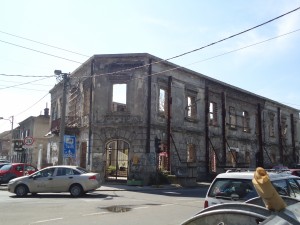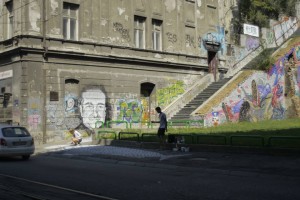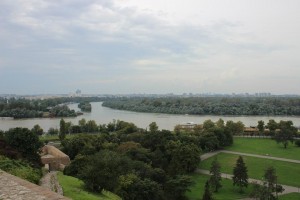A significant part of adjusting to Belgrade has been about processing everything that I see during my daily routine. There is the bus I take, recently jam-packed with commuters, and the familiar voice constantly announcing sledeća stajalište (“next stop”). When I step off the bus and onto the street, there is often the smell of cigarette smoke, and I typically witness people jaywalking across the street after looking both ways to make sure the police don’t see them. Sometimes I see a policeman jaywalking with them. Every so often, drivers get confrontational and blare their horns for a good 20 seconds; once or twice I’ve seen drivers leave their cars to yell at each other or greet a friend before driving away. If I’m on my way to an early morning class, I pass by trucks delivering fresh bread and groceries to the bakery and convenience store on the corner. When I remember to look up, I see buildings from various time periods looming above; some of them are modern, some have been standing for centuries, while others feature the concrete, blocky facade of communist architecture.
Historians often mention how cities are layered with history, how the bones and ruins of ancient civilizations lay beneath successive layers of streets. In Belgrade these layers are vertical, too. Even a single building can have layers from the inside-out. In daylight, I pass many buildings that look decrepit and abandoned (one of them didn’t even have a roof or glass in the windows); when I pass by at night, however, those buildings come alive with the lights, sounds, and smells of Belgrade nightlife. No corner in this city goes to waste–if there’s room, there will be a cafe or kafana.*

One of the buildings I passed that appears abandoned. It is a project in the Savamala area (a scene where Belgrade’s youth gather) known as “the Spanish House.”
Yet, the most startling element of my surroundings is something that isn’t foreign to me at all: graffiti. And it’s everywhere.
Graffiti here ranges from meaningless scribbles on the bus to elaborate, politically charged street art. In some cases, graffiti is how local residents express their political views and frustrations. In other cases, it reveals hostilities between people with opposing values. I’ve come across negative, hostile, even chilling sketches; I’ve also seen constructive and inspiring critiques of Serbian society.
One particularly haunting image I passed featured Gavrilo Princip, infamous for assassinating the Archduke Franz Ferdinand and igniting World War One. Princip remains a controversial figure, for according to some he is a terrorist while according to others he is a national hero. Serbia’s way of handling this controversy delicately was to name a street after Princip, but to choose a street that was not significant (in fact, this street is where prostitution in Belgrade took place). The original artwork displays Gavrilo Princip and the words he wrote on the wall of the cell where he was detained until his death: “Our ghosts will walk through Vienna, and roam the Palace, frightening the Lords.” Like many things written on the walls of Belgrade, however, this street art has layers: someone else came alone one day and blinded Princip by painting his eyes white; yet another passerby later added the symbol for marijuana, maybe indicating that the past is irrelevant to them.

The original graffiti (accessed http://www.vaseljenska.com/wp-content/uploads/2011/07/Gavrilo-Princip-1.jpg)
The graffiti now, after numerous contributions.
I also pass by graffiti addressing current politics–especially concerning Serbia’s recognition of gay rights. This weekend, Belgrade held its first Pride Parade in several years; I’m happy to report that it was safe and successful, but not without a considerable amount of resistance. Belgrade’s street art reflects this dynamic, as some graffiti advocates gay rights and other graffiti is crudely added on top of it with expressions of open hostility.
Unlike graffiti in the United States, which is usually washed away or painted over, Belgrade’s messages become a part of the city’s atmosphere (most likely because there is neither money nor priority to undo it). Graffiti is also something that happens in broad daylight. I’m not sure if it’s completely legal, if street artists get lucky and escape the attention of the police, or if the police look the other way… regardless, I’m getting used to seeing those faces stare back at me every morning. Belgrade’s graffiti is yet another way for me to learn the language and social dynamics here. It makes the walls come alive–they evolve with the times and document the city’s history. Many people here keep telling me that Belgrade has a soul; I think they’re right, and I think its secrets are written on the walls.

Two teenagers spray-painting a new image onto the street. And yes, that is Robin Williams on the wall (he appeared there the day after his death).
*more traditional bars/cafes known for playing local music
